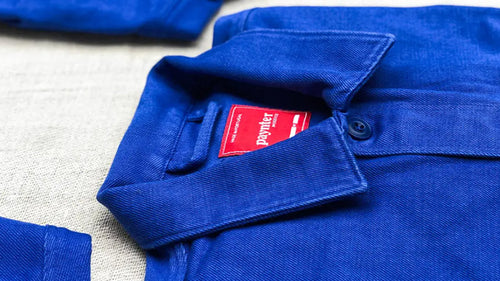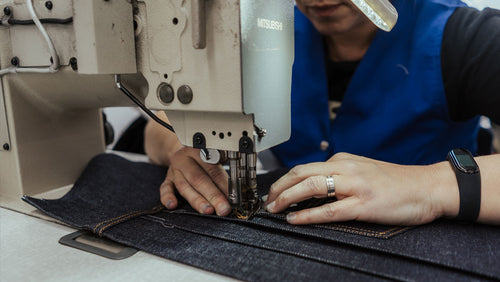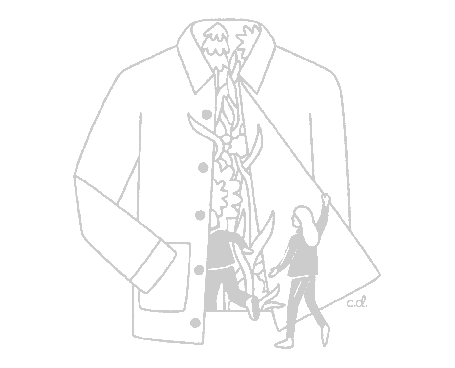Behind the scenes of our jacket making process.
It's raw and it's real. Here's what happened from the first sample to the final.
Batch Notes - The Field Fatigue
...
You're no stranger to wearing military gear. Ok, so you might not be kitted out head to toe in surplus, but you'd be surprised how much of a solid wardrobe get's it's origin from battle. Chinos. Macs. Doc Martens. Bombers. Camo.
It was January when the work on our third jacket began, but it really goes back a long time before then. We've spent a lot time rifling through military jackets in vintage shops and archives.
...
Jan '19 - April '19
Our trips to archives, vintage shops, surplus stores continue but with a new purpose. We're hunting for the little details that make or break jackets. The stitching, shapes, labels and buttons that give killer jackets their character.
...
April'19
We fall in love with two styles. The Jungle Fatigue jacket, and the Field jacket.
Before we tell you about the making of our jacket, here's why we love these two iconic jackets.
The Jungle Fatigue jacket

Jungle Fatigue jackets were buttoned, lighter weight jackets worn in tropical climates in the mid to late 60s and into the 70s. The style is well known for it's angular pockets with a central bellow.
The Fatigue started being produced in 1963, made from poplin, before switching up to ripstop around 1967 - 1968. The first iteration had exposed buttons outside of the pocket flaps, but they were soon tucked underneath the flap because they kept falling off during combat. During the redesign the shoulder epaulets were stripped back too. What was left was beautiful. And practical.
The most popular among vintage collectors is the later edition OG 107 Jungle Fatigue. The OG 107 was produced in two classes depending on which division the wearer was part of.


Images: our own. Credits to The Vintage Showroom & their archive, full of these gorgeous relics.
The Field jacket
A style that's timeless and easy to wear, super versatile and more refined again than the fatique 107. Done right, it's a staple that goes with anything.
What we're not so keen on is the fit. Vintage Field jackets are often baggy, too 'replica', too 'costume'.
And so we got thinking about the details we wanted to change, details we'd bring across from the fatigue jacket, and how we'd merge our trusted fit with this iconic piece.
The simplicity of a Field jacket done right is a real classic in any wardrobe, especially when you push beyond the classic military green.

...
April '19
We start looking for Herringbone fabrics.
Mixing military style with the soft, subtle nature of fine herringbone was exciting.
Less harsh, more characterful. A fabric looks better the more and more it's worn.
...
May '19
Soon enough, it's tech pack time.
All those learnings and ideas are compiled into technical drawings, measurements, photos and fabric cuttings. Everything is packaged up and sent to Sergio as an instruction manual for our first jacket sample.
May ‘19
We get talking to a Japanese Mill who Huw has known for years. Sourcing denims for Hiut Denim has meant a black book full of names and relationships with some of the world's best mills.
May ‘19

We receive post from Japan. Inside is a swatch of herringbone. It's a beauty. It's also eye wateringly expensive, but we'd just been listening to How I Built This with Jerry Murrell, the founder of Five Guys. He preached about finding the very best ingredients, and worrying about price later. We liked his ideas and so with Jerry in mind, we ordered 1 roll of Japanese Herringbone to sample with.
May ‘19
Head vs heart.
An internal debate about quality vs mileage begins.
Is it right to source in Japan and fly the fabric to Portugal? For us, quality is the most important thing when it comes to sourcing, but when does that balance shift to being just too far away to feel right?
No rash decisions are made, but it's a subject we're giving a lot of thought to.
...
May ‘19
Sergio receives the sample meters from Japan and runs shrinkage tests on the fabrics.
...
June '19
We finish the design of our Field Fatigue jacket and we send a tech pack to the factory to make our first sample.
A tech pack is like an Ikea instruction manual for how we’d like our jacket to be made.
...
June '19
We ask Sergio not to use the Japanese fabric for the first sample he makes. We ask him to use an alternative Herringbone for the first sample. That's because our roll of fabric will only go so far, and we know from past experience that when it comes to the first sample, there will be a lot to change. We're super picky. So we'd rather test the shape, fit and details first, and work up to the right fabric when we're ready.
...
July '19

Sample No.1 arrives.
We're in the carpark in Tesco in this photo, it was the first place we could get out of the car and try it on.
See the look on Huw's face? It's confusion. The fabric is gorgeous. It feels just like the Japanese Herringbone. We're both a bit worried that Sergio didn't get the message about holding back that roll until later...
It's also too small, likely due to shrinking more during the dying phase than we'd planned. That's an easy fix for our next sample.
...
July '19
Back in the car and driving home, we're talking about the details we like, and the tweaks we already know we want to change. We love the side adjustment tabs, the slightly tweaked back shape, our concealed button tab and the pointed tabs on the cuffs.
Wear testing will show us how the pockets function, whether the weight is right and if any other details need seeing to.
July ‘19
An email arrives from Sergio.
The Herringbone fabric he'd used to make our first sample wasn't the Japanese. It was Portuguese. And it was made in the same town as our factory is based, Guimarães. What were the chances?
July ‘19
So Becky takes on the task of wear testing our first sample.
Thankfully July wasn't a hot month so she managed to get some good hours of wear testing in from then onwards.
The first tweak is obvious. The button tab on our cuff isn't quite lining up where it should. That's an easy one to fix.

July ‘19
Walking around, phone in pocket, podcast in ears, we quickly notice the second tweak. The pocket bags are big, and they're sagging too low. It looks too 'sloppy'. Not our style.
We're thankful that make jackets with plenty of time to test and notice these details long before they're produced. If we didn't test our jackets, it would be our customers who would notice the small details that need updating. It's those details that make a jacket one you wear day in, day out.
...
Aug ‘19
 Originally, our pockets had double button closure just like the second iteration of the OG 107 Jungle Fatigue - a button at each side that matches neatly with the underside of the button flap, concealed when done up.
Originally, our pockets had double button closure just like the second iteration of the OG 107 Jungle Fatigue - a button at each side that matches neatly with the underside of the button flap, concealed when done up.
But wearing day in, day out, taught us that although that makes for a very secure pocket, it's really hard to open with one hand. And when you've got things to carry, it's not great to have a pocket you couldn't easily open.
So we updated this detail to a sharp, single button closure with a concealed pointed tab, underneath the pocket flap, like this -

Aug ‘19
Our tweaks are written and sketched up, and sent to Sergio and Sandra, head of Pattern Cutting to make changes.
...
Aug '19
We decide which fabric we're going to use for Batch No.3.
It was an easy decision to make.
Japan: Quality = 10. Air Miles 6,700.
Portugal: Quality = 10. Air Miles = 0.
No brainer.
...
Sept ‘19
Meanwhile illustrations are flying back and forth between London, South Wales and New York, between us and our designer Batch No.3's limited edition label.
The brief this time was to show the people involved behind the scenes of making a jacket.
...
Sept ‘19

We're in Paris and who can resist a trip to Gauthier Borsarello's archive 'Le Vif' to check out any last details to add.
Oh, and we get side tracked, obviously.


Sept ‘19
Sergio and Sandra are work on making tweaks to the pocket bags. To make sure they've got the new dimensions right, they mock up just the front of the jacket to show us the new scaled proportions.
It's perfect.
But with no arms and no back, it's definitely not a wearable piece 😂.
Sept ‘19

We decide to work with our friends Andrea & David Courtney again for Batch No.3's buttons. They make stunning buttons made from Corozo nuts, in Britain.
This couple are pretty damn inspiring. Scroll down to see the newspaper advert they saw about their local button factory closing down. It wasn't long until they saved it. Neither of them had experience making buttons before.
It's amazing to see how two people can perfect a new skill making Corozo nut buttons while also being hands down the most positive people to pick up the phone to. I hope we continue to work with Courtney for a long time. Because buttons aside, they're great people.

Oct ‘19
It's time to decide on the colours we're going to make for Batch No.3, other than the definite military green.
At this point, you step in and help us decide by voting for your favourite colours.
Alongside our classic green and dark navy, you vote for sand, mustard yellow, dusty pink, black and burgundy.
Oct ‘19

So, we get lab dips of every colour, with 3 - 4 shades of each one.
We decide on one shade of each colour: Military Green, Deep Navy, Sand & Mustard:
Nov ‘19
Now we've decided on the colours for our jackets, we send the swatches to Courtney & Co to match the button colour to the fabric colour.
Nov ‘19
Shoot planning begins.
We decide to shoot with iPhone, the tool that we all have in our pocket.
We plan to build our own “studio”, at home.
This time, we're taking the shots then weaving them into collages using photos that our community have sent us, photos they have taken with their phones, from all over the world.
The Jungle jacket was built for adventure, so here's to a new kind of adventure.
Nov ‘19
Our friends from around the world send us photos. There are hundreds. Seeing the photos flood in, and the descriptions that accompany them make us feel like slowly but surely we're getting to know the people that we're making for.
Dec ‘19
Our final samples arrive just in time for our photoshoot. They're beautifully made. Thank you to Sergio and our team.
There's deep navy, military green, sand and mustard.
Dec ‘19
Our shoot takes place. It's so fun. We had Jim Marsden involved behind the lens again, this time using iPhone not film. An unusual territory for Jim and a challenge for him to see what's possible with a device we've all got. The results are incredible.

Dec ‘19
The very next day, Batch No.2 arrives. 300 jackets need packing. Between the two of us and with a lot of help from Becky's parents, we check and pack each and every jacket before it heads to it's new home.
We're looking forward to the Christmas break, when we'll get time to edit and collage our photos. Bring it on. Mulled Wine. Warm Fire. Collaging sessions. 🔥
Dec ‘19
Our idea of the Christmas break, before it began: Loads of time. Family time. Lolls. Games. Walks. Plenty of time for collaging after our photoshoot, ahead of our campaign launching in January 2020. Visiting friends in Scotland, after spending time at home with family in Wales then Chester.
Reality: 5 days away from work enjoying the holidays and spending time with family. Exactly what we needed. Then, we hit the road for 5 days in Scotland. We covered over 1,500 miles in the car. Plans and ideas are flowing, because we're both working full time on Paynter from January 2020.
Jan ‘20
We're both full time. Oh woah.
We pay Sergio a part payment ahead of placing our order with him at the end of the month. Paying him on time means he can pay for our fabric, without being out of pocket. Plus, bargaining really isn't great for quality, or long term relationships.
Jan ‘20
 Tech packs are locked down and confirmed.
Tech packs are locked down and confirmed.
The fabric is being made.
The factory is ready.
...
Batch No.3 will be available to order from 9am on 25th of January 2020.
If you'd like to stay updated, sign up to our newsletter at the bottom of this page.
...






